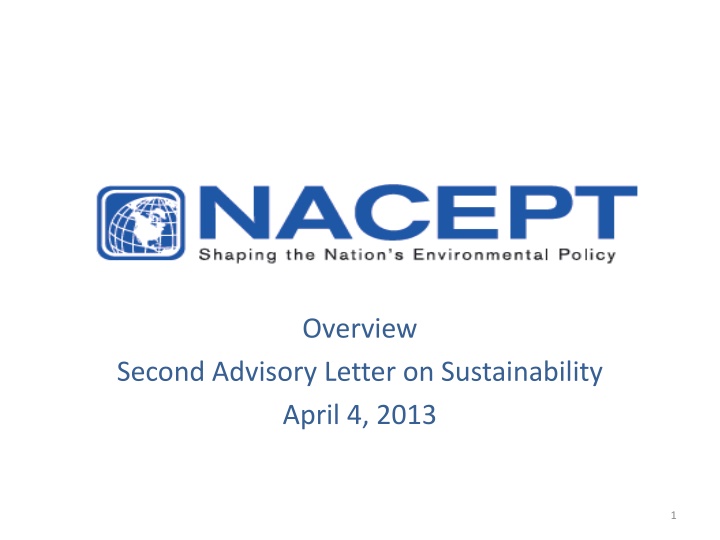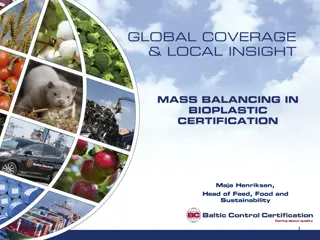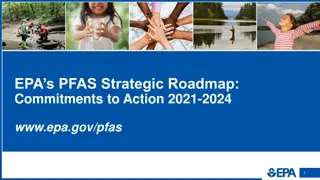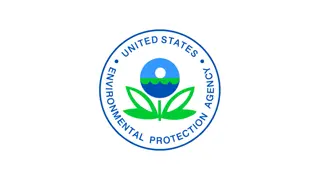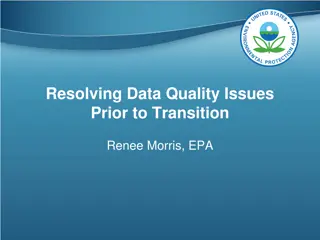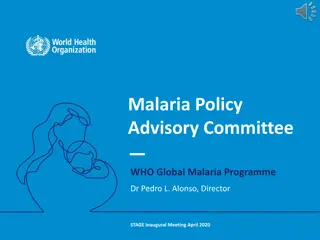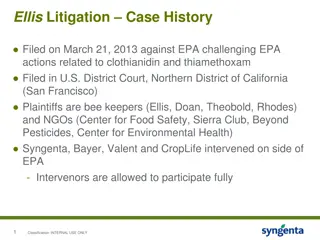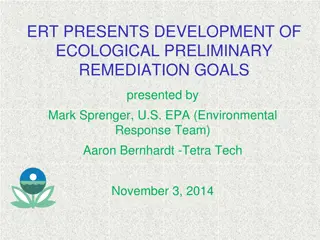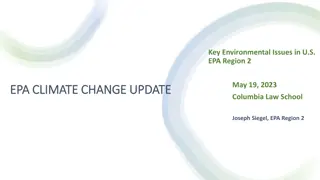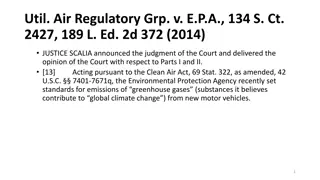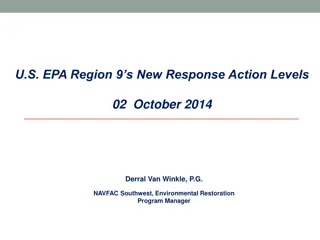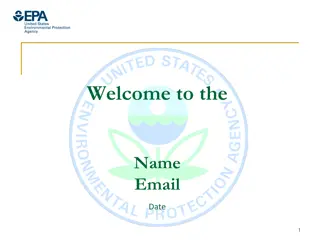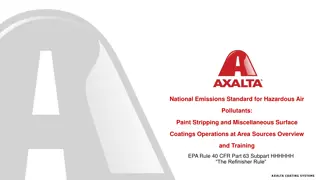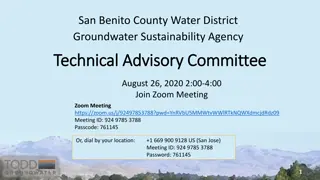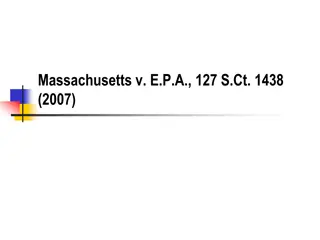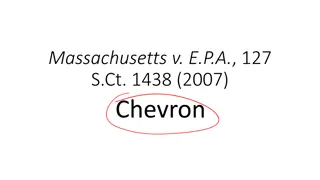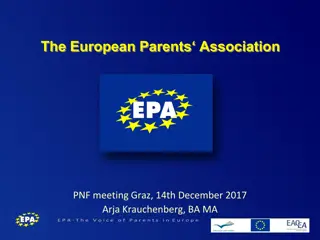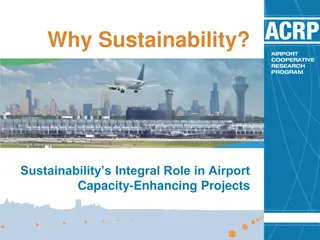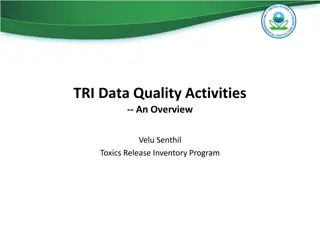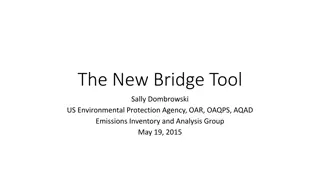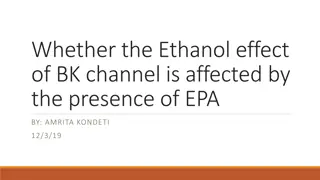EPA Sustainability Advisory Recommendations
EPA's Advisory Letter on Sustainability outlines recommendations to align EPA on the path to sustainability, engage stakeholders effectively, and demonstrate sustainability leadership. The recommendations include building a robust sustainability strategy, adopting a compelling vision, clarifying the mission statement, setting breakthrough objectives, and developing quantitative metrics for analyzing impacts.
Download Presentation

Please find below an Image/Link to download the presentation.
The content on the website is provided AS IS for your information and personal use only. It may not be sold, licensed, or shared on other websites without obtaining consent from the author.If you encounter any issues during the download, it is possible that the publisher has removed the file from their server.
You are allowed to download the files provided on this website for personal or commercial use, subject to the condition that they are used lawfully. All files are the property of their respective owners.
The content on the website is provided AS IS for your information and personal use only. It may not be sold, licensed, or shared on other websites without obtaining consent from the author.
E N D
Presentation Transcript
Overview Second Advisory Letter on Sustainability April 4, 2013 1
Charges to NACEPT & Work Approach EPA Charge # 1 Describe challenges, barriers, opportunities, stakeholder engagement needs & recommendations to help EPA implement a sustainability strategy EPA Charge #2 Recommend a vision, mission, measurement systems, ways to share progress, tools and 3-5 year breakthrough objectives to propel EPA s sustainability implementation Work Team: Ron Meissen (Co-chair) Alison Taylor (Co-chair) Fernando Abru a Ondrea Barber John DeVillars Giovanna Di Chiro Deeohn Ferris Trish Gallagher Sara Kendall Howard Learner Work Team Bridgett Luther (Co-chair) Olufemi Osidele (Co-chair) Erica Bannerman Kurt Erichsen DeWitt John Robert Kerr Judith Mazique Mark Mitchell Bob Olson Yalmaz Siddiqui Note: Full charge questions included in the Appendix 2
NACEPTs Recommendations Address Three Areas I. Aligning EPA on its Path to Sustainability II. Ensuring Stakeholder Engagement III. Demonstrating Sustainability Leadership Overall: these recommendations provide EPA a sustainability implementation roadmap 4
I. Aligning EPA on its Path to Sustainability Summary of Recommendations Recommendation 1: EPA Should Build Upon Its Significant Strengths To Develop And Deploy A Robust Sustainability Strategy. Recommendation 2: EPA Should Adopt A Compelling Vision Based Sustainability Principles And The Needs Of Present And Future Generations. Recommendation 3: EPA Should Clarify And Expand Its Current Mission Statement To ExplicitlyReflect A Sustainability Approach. Recommendation 4: EPA Should Endorse A Small Number Of Breakthrough Objectives To Achieve By 2020 To Accelerate Implementation Of Its Sustainability Strategy And Demonstrate Visible Leadership. Recommendation 5: EPA Should Develop Quantitative Metrics To Analyze Net Impacts And Benefits Of Decisions In Terms Of Contributions To A More Sustainable Society And Incorporate These In Goal-Setting Processes. 5
II. Engaging Stakeholders Summary of Recommendations Recommendation 6. EPA Should Clearly Connect Its Sustainability Strategy To Its Existing Authorities And Engage Stakeholders In Implementation. Recommendation 7: EPA Should Link Sustainability, Community Engagement And Environmental Justice Approaches Across EPA. 6
III. Demonstrating Sustainability Leadership Summary of Recommendations Recommendation 8: EPA Strengthen Sustainability Capabilities In Its Organization And Culture: Leadership, Innovation, and Collaboration. Recommendation 9: EPA Should Enhance Its Presence In Sustainability Both Inside The Agency And Across The Federal Government. Recommendation 10: EPA Should Enhance Its Role As A Convener To Include Discourse On Sustainability And Collaboration Involving Government And Society At Large. 7
Discussion 1: EPA Vision Statement 1) EPA s Vision is to propel America towards sustainability, protecting the environment and health in a way that meets the environmental, social and economic needs of the present without compromising the ability of future generations to meet their needs. 2) EPA Vision is a more sustainable American society and environment, now and for future generations. NACEPT: Recommend 1 or 2 or both or different? 9
Discussion 2: EPA Mission Statement 1) EPA s Mission is to improve human health and the environment while maintaining or enhancing quality of life. 2) EPA s Mission is to improve human health and the environment and to encourage actions and solutions that advance the health, well-being and benefit of all. 3) EPA s Mission is to improve human health and the environment while advancing long term economic viability and the quality of life for all Americans. NACEPT: Recommend 1, 2 or 3, all or different? 10
Breakthrough Objectives Recommended Criteria Breakthrough Objectives must: Support the Sustainability Vision Encompass new and/or more effective directions for the Agency to take. Improve performance throughout the Agency, not just in one area Advance environmental, social and economic goals. Be implementable and measurable at national, state and community scales Be able to be completed in 3-5 years Be simple and intuitively understandable 11
Discussion 3: Breakthrough Objectives NACEPT Recommended Options 1. By 2020 EPA will facilitate a number of green infrastructure projects that deliver regulatory performance comparable or superior to conventional pollution control systems, but at lower costs, with higher conservation values and outcomes, and measurable net job creation. 2. By 2020, work with a few high carbon-emitting industries (steel, cement, aluminum, paper and plastic) to develop incentive approaches to help those industries achieve a 25% increase in energy and carbon efficiency while demonstrating beneficial economic results. 3. EPA will work with priority businesses and or communities to reduce water, carbon and waste emissions by 2020 and demonstrate continued or improved quality of life. 12
Breakthrough Objectives Options, cont d 4. By 2020, work collaboratively with highly impacted communities to reduce soot without raising the price of electricity, nor causing disproportionate impacts on affected low-income communities or resulting in significant reduction in local employment. 5. By 2020, foster a one EPA culture using sustainability as a focal point and by dramatically increasing collaboration across departments and creating joint programs with measurable outcomes. 6. By 2020, EPA will demonstrate measurable progress to become carbon positive and outline a plan to achieve that across the Agency. 13
Breakthrough Objectives Options, cont d 7. EPA will help the federal government achieve 95% sustainable purchasing for all goods and services (with the exception of weapons systems) used by the U.S. government. 8. By 2020, EPA will help America's industries achieve a 20% reduction in product lifecycle environmental and human health impacts, while improving their long- term economic competitiveness and job-creation potential. 9. EPA should provide a framework for educating the next generation of decision-makers about sustainability. 14
Graphic Depicting EPA Internal Alignment Vision Option 2 EPA Vision is a more sustainable American society and environment, now and for future generations EPA s Mission is to improve human health and the environment, while maintaining or enhancing quality of life Mission Option 1 2020 2020 2020 Objective Office of the Administrator Goals, Indicators and Metrics. Roll up to Objectives, Mission and Vision objective Objective Office of Chemical Safety & PP Goals, Indicators and Metrics. Roll up to Objectives, Mission and Vision Office of Air & Radiation Goals, Indicators and Metrics. Roll up to Objectives, Mission and Vision Office of Enforcement & Compliance Goals, Indicators and Metrics. Roll up to Objectives, Mission and Vision Goals, Indicators and Metrics. Roll up to Objectives, Mission and Vision Etc. 15
Next Steps EPA feedback on final revised draft NACEPT discussion & finalization of recommendations: 10 recommendations Vision options Mission Options Breakthrough Objectives Other Input Adopt 16
APPENDIX 17
EPA Charge Question 1 1. What strengths can EPA leverage to successfully deploy, across the Agency, sustainability strategies drawing upon both the National Academies report recommendations and, also, approaches to sustainability and recommendations from other sources and stakeholders? How can EPA's deployment also achieve positive influence with other agencies and stakeholders? Are there internal or external challenges barriers and gaps that EPA will need to address, manage and overcome to successfully deploy sustainability strategies drawing upon both the National Academies report recommendations and, also, approaches to sustainability and recommendations from other sources and stakeholders? (1) Identify the significant internal challenges and then recommend strategies to address, manage and overcome them; and (2) Identify the significant external challenges and the stakeholders involved, and then recommend strategies to address, manage and overcome them and contribute to the EPA s successful roll-out of its defined sustainability strategy while engaging with key stakeholders. 18
EPA Charge Question 2 2. Using EPA Sustainability Vision as a starting point, and back-casting from that vision, what breakthrough objectives does NACEPT recommend for EPA over the next 3-5 years drawing upon both the National Academies report recommendations and, also, approaches to sustainability and recommendations from other sources and stakeholders? -- What measurement systems does NACEPT recommend for assessing progress towards these breakthrough objectives and EPA s sustainability vision? -- What tools are available to help EPA consider the qualitative and quantitative environmental, public health, social and economic benefits? -- What approaches should EPA use to share progress with the public? -- What other new approaches might be necessary to implement the breakthrough goals that NACEPT has identified? 19
